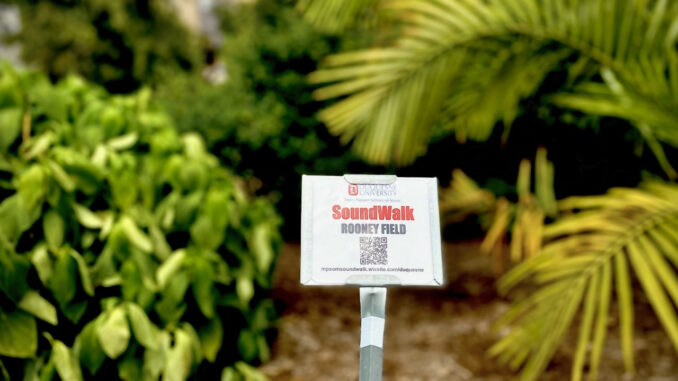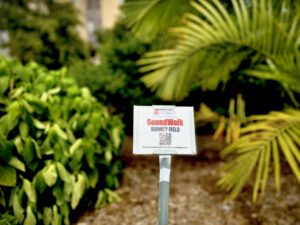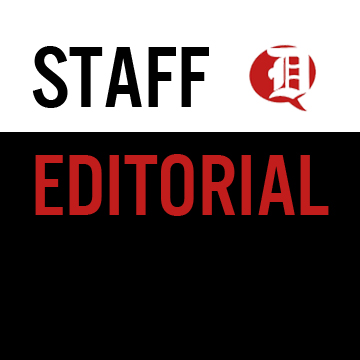
Rio Scarcelli | staff writer
9/2/21

Ambience is an idea most associated with sight. When taking in a cityscape or strolling through a park, the first things to come to mind may be the scenery or terrain.
Instead, what if an area’s quality was first experienced through sound?
This is what students of the Mary Pappert School of Music sought to highlight with their very own SoundWalk on various spots of Duquesne’s campus. Led by Assistant Musicianship Professor Nicole Vilkner, her 2020-21 Music and Soundscape class made a year-long project out of touring a space through your ears.
A “SoundWalk,” Vilkner explained, originated in the 1970s around areas of New York City. Without the technology, people were given signs that pointed them to different locations to take in the natural sounds of a geographic area. This could include birds chirping, leaves rustling or even booming city traffic.
“I thought it would be so neat to do something like that with the class and have them choose their own sounds to create an interactive tour of campus on different sites,” Vilkner said. “[Music and Soundscape] was designed to stray away from the typical research paper and a final product. We wanted to collaborate to make a final project that the class would produce. Everyone had their own theme and the intricacies went from there.”
School of Music alumna Katie Tonkinson was one of 15 students to adapt this idea using modern technology to highlight their own portion of campus in a specific SoundSite. The 15 sites can be found in locations* such as Lourdes Grotto, the Chapel Bell, Locust Garage, Academic Walk, Bluff Street, the Union and the Incline among many others.
“We studied the history and origins of the subject together as a class before individually focusing on creating our specific SoundSites,” Tonkinson said. “Eventually, this served as our final project for the semester.”
After learning the history, Vilkner and her students applied their knowledge of natural and manmade soundscapes to do their own intensive exhibit on schools, fields and walkways within Duquesne. To portray this, they used the adaptable idea of signs with QR codes placed on stakes around campus.
“Using QR codes truly allowed anyone on campus to access the SoundWalk at any moment. In this age, we can all agree that we carry our phones with us all of the time,” Tonkinson stated. “This gives every participant an equal opportunity to experience the SoundWalk whenever it is convenient for them.”
All of this work was placed into a small, easy-to-access space that students can access at any time if they have a minute to spare. Part of the project was making sure that the SoundSites were not only simple to catch on to, but also a fun perspective to gain about the way a certain student views the scenery of Duquesne.
Before they could undergo the task, there was a learning curve that had to be addressed: the ‘technical chops’ to complete a SoundWalk.
“As a class, part of our hurdle was learning how to produce a SoundWalk,” Vilkner said. “We found out how to develop websites, how to embed links and audio files in QR codes and even what the revision process was like when making a website public.”
Vilkner explained that every student took a different approach to the way you could hear certain aspects of the campus.
“Some of the ideas were natural, with examining the animal sounds in the area and others took on a historic view,” Vilkner said. “One of my students got to learn that Academic Walk used to be a roadway. The unique perspectives each took shape when deciding what part of campus they wanted to focus on.”
With months of research and continual revisions came the development and launch of their website for anyone to see. There are many ranges of views that students presented, and Tonkinson feature birds around campus. Different kinds of bird songs were played around the site and were highlighted through the lens of music. It showed the ways that music pulled from bird songs and what natural tunes we experience through animals.
“I was so excited to learn how many birds can be found in Pittsburgh and at our school. As a floutist, many of our famous solos are inspired by birdcalls and birdsong,” Tonkinson said. “It was a very fascinating experience to connect my musical lessons to ornithology and analyze if birds, themselves, can be musicians too.”
Tonkinson’s view is one of many vastly different perspectives that highlights aspects of campus that students may not pay attention to in day-to-day life. Covid-19 resulted in many of the natural sounds of traffic, animals and peer-to-peer conversation being entirely altered. Social distancing and the lack of people in a space made for a lack of sound as well.
“Specifically, the time we chose to do this was remarkable because of Covid-19,” Vilkner said. “Campus did not sound like anything it used to. There were animals that were coming out in spaces that used to be occupied by traffic. Students interacted and spoke to one another differently. This gave us the perfect opportunity to show what kind of sounds that you would not normally think about missing on campus during any other time.”
The dichotomy of Pittsburgh was something that Tonkinson and her peers found most interesting when examining a city environment surrounded by elements of nature. She explained that she learned to appreciate the louder sounds of traffic and bustling city environment that embellished the way we live.
“My favorite aspect of Duquesne’s soundscape is the unique dichotomy of being located in a city environment while still being able to find elements of nature,” Vilkner said. “While there is an innate tendency to assume the often louder, stereotypical noises of the city have a negative connotation, we learned to challenge that notion and embrace those sounds that contribute to our daily environment. The traffic on Forbes or 376 no longer represented a disturbance, but instead, a reminder of our contribution to Pittsburgh as a whole.”




